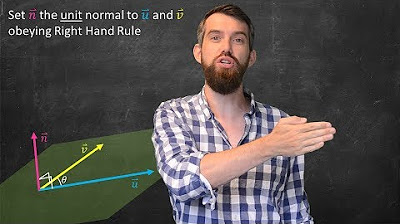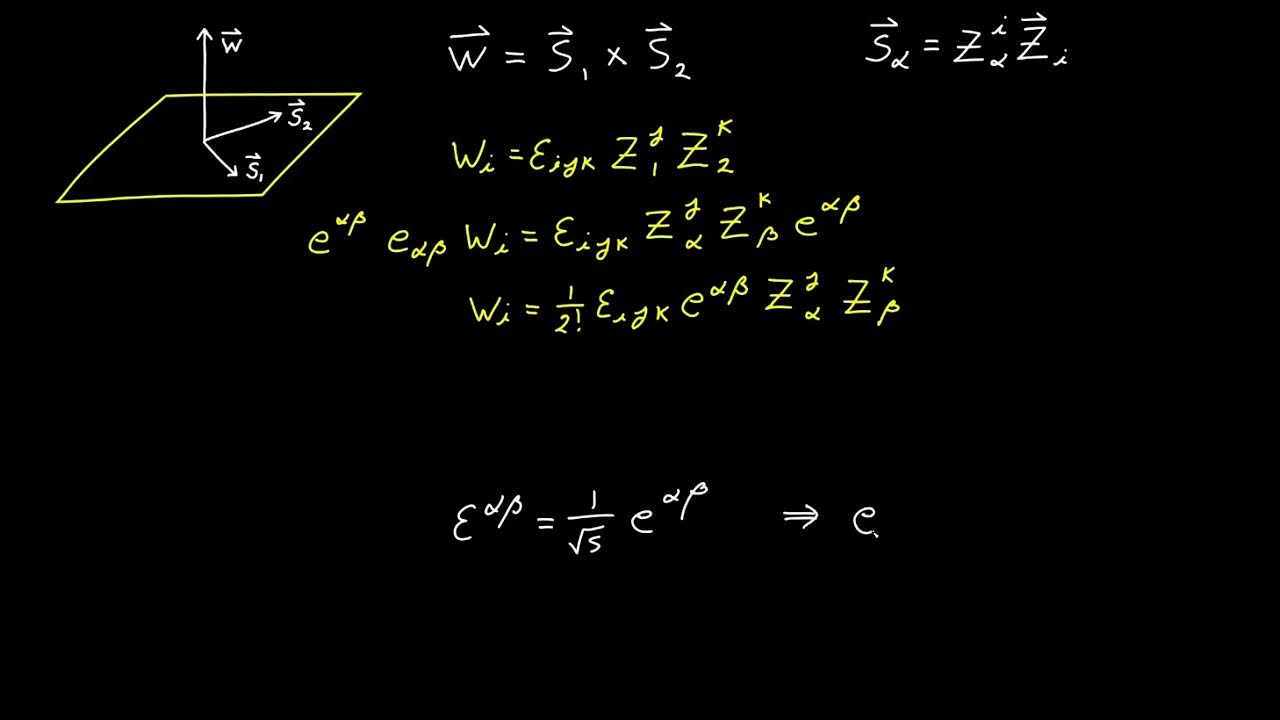Constructing a unit normal vector to a surface | Multivariable Calculus | Khan Academy
TLDRThe video script delves into the concept of constructing a unit normal vector for a surface, which can be parametrized by a position vector function of two parameters, u and v. It explains how the partial derivatives of the position vector with respect to u and v can be used to determine the tangent vectors on the surface. By taking the cross product of these tangent vectors, a normal vector perpendicular to the surface is obtained. The script then describes how to normalize this normal vector to get the unit normal vector, which is crucial for various applications in vector calculus. The explanation is complemented with a right-hand rule analogy for determining the direction of the cross product.
Takeaways
- 💡 The surface can be parametrized by a position vector function r, which is a function of two parameters, u and v, specifying points on a two-dimensional surface in three-dimensional space.
- 🔬 To construct a unit normal vector at any point on the surface, it's crucial to understand how the surface can be represented by these parameters.
- 👉 Incrementing u or v slightly moves us to another point on the surface, and the direction of movement is tangential to the surface, represented by partial derivatives r_u and r_v.
- 🚨 The magnitude of r_u and r_v depends on how fast we move towards the new point, but their direction is along the surface, tangential at the point of consideration.
- 📌 r_u and r_v are not necessarily perpendicular to each other but are both tangent to the surface, indicating the slope in their respective directions.
- 🛠 Combining r_u and r_v specifies a plane tangent to the surface, and taking their cross product gives a vector normal to this plane and thus perpendicular to the surface.
- 🔨 The cross product of r_u and r_v results in a normal vector, not necessarily a unit vector, indicating its perpendicularity to both r_u and r_v and the surface.
- 💪 To determine the direction of the normal vector, the right-hand rule is applied: thumb in the direction of r_u, index finger in the direction of r_v, and the middle finger will point in the direction of the normal vector.
- ✅ Normal vectors can point in two directions: outward or inward. The direction is essential for understanding the orientation of the normal relative to the surface.
- 🎸 The unit normal vector is obtained by normalizing the normal vector, dividing it by its magnitude. This vector is a function of u and v and provides a precise way to specify orientation at any point on the surface.
Q & A
What is the main topic of the script?
-The main topic of the script is the concept of surface integrals and the construction of a unit normal vector at any point on a surface.
How is a surface represented in the script?
-A surface is represented by a position vector function, r(u, v), where u and v are parameters that specify a point on the two-dimensional surface embedded in three-dimensional space.
What are the partial derivatives of the position vector with respect to u and v, and what do they represent?
-The partial derivatives of the position vector with respect to u and v, denoted as r_u and r_v, represent the tangent vectors to the surface at a given point. They indicate the direction and rate of change along the u and v parameters respectively.
Why are the tangent vectors r_u and r_v important?
-The tangent vectors r_u and r_v are important because they help in determining the local orientation and shape of the surface at a given point, which is essential for constructing a normal vector.
How can you obtain a normal vector to the surface?
-A normal vector to the surface can be obtained by taking the cross product of the tangent vectors r_u and r_v. This resulting vector is perpendicular to the plane defined by the tangent vectors.
What is the significance of the cross product of two vectors?
-The cross product of two vectors yields a third vector that is perpendicular to both original vectors. In the context of the script, it provides a normal vector to the tangent plane of the surface at a given point.
How do you determine the direction of the cross product?
-The direction of the cross product can be determined using the right-hand rule. You point your right thumb in the direction of the first vector and your index finger in the direction of the second vector; the direction in which your middle finger bends inward represents the direction of the cross product.
What is a unit normal vector, and how is it derived from a normal vector?
-A unit normal vector is a normal vector with a magnitude of one. It is derived from a normal vector by dividing it by its magnitude, which normalizes the vector, making it a unit vector that points in the same direction but with a length of one.
How is the unit normal vector expressed in terms of the position vector and its partial derivatives?
-The unit normal vector is expressed as the cross product of the partial derivatives of the position vector with respect to u and v, divided by the magnitude of that cross product: (r_u × r_v) / ||r_u × r_v||.
What are the potential applications of understanding how to construct a unit normal vector?
-Understanding how to construct a unit normal vector is crucial in various fields of mathematics, physics, and engineering, as it helps in modeling surfaces, calculating surface integrals, and solving problems related to orientation, curvature, and reflection on surfaces.
What will be covered in future videos regarding this topic?
-In future videos, the concept will be applied to concrete examples, demonstrating the process of constructing a unit normal vector for specific surfaces and exploring further applications of this mathematical tool.
Outlines
📐 Constructing a Unit Normal Vector
This paragraph delves into the concept of creating a unit normal vector for a surface that can be parametrized by a position vector function, r(u, v). It explains how by varying the parameters u and v, one can identify points on the surface and determine the tangent vectors r_u and r_v. The discussion then leads to the cross product of these tangent vectors, which yields a normal vector to the surface. The right-hand rule is introduced to describe the direction of this normal vector, which points outward from the surface. The paragraph concludes with the understanding that to obtain the unit normal vector, one must normalize this cross product by dividing it by its magnitude.
📌 Normalizing the Normal Vector
The second paragraph focuses on the process of normalizing the normal vector obtained from the cross product of r_u and r_v. It emphasizes the importance of choosing the correct direction for the normal vector, which in this context is upwards, away from the surface. The paragraph explains that to convert the normal vector into a unit normal vector, one must divide it by its magnitude. The resulting unit normal vector is a function of both parameters u and v, and it provides a precise orientation at each point on the surface. The summary ends with a note that future videos will demonstrate this process with concrete examples.
Mindmap
Keywords
💡Surface Integral
💡Unit Vector
💡Parametrization
💡Position Vector
💡Partial Derivative
💡Tangent Vector
💡Cross Product
💡Normal Vector
💡Unit Normal Vector
💡Normalization
💡Right-hand Rule
Highlights
The concept of a surface integral is introduced, which could represent various physical quantities.
A method to construct a unit normal vector at any point on a surface is discussed.
The surface is assumed to be parametrized by a position vector function r(u, v).
The position vector r specifies a point on the two-dimensional surface in three-dimensional space.
The partial derivatives of r with respect to u and v, denoted as r_u and r_v, represent directions tangent to the surface.
The r_u vector indicates the direction of change as u is incremented.
The r_v vector indicates the direction of change as v is incremented.
r_u and r_v are not necessarily perpendicular to each other but are tangential to the surface.
The cross product of r_u and r_v yields a vector that is perpendicular to both, thus defining a normal vector to the surface.
The cross product of r_u and r_v gives a vector that lies in the tangential plane of the surface.
The right-hand rule is used to determine the direction of the cross product of r_u and r_v.
The normal vector can point outwards or inwards from the surface, depending on the orientation.
The unit normal vector is obtained by normalizing the normal vector obtained from the cross product.
The unit normal vector is a function of both parameters u and v.
The unit normal vector is calculated as the cross product of r_u and r_v divided by the magnitude of the cross product.
Concrete examples of constructing a unit normal vector will be provided in future videos.
Transcripts
Browse More Related Video

Geometrically Defining the Cross Product | Multivariable Calculus

Stokes example part 3: Surface to double integral | Multivariable Calculus | Khan Academy

Vector representation of a surface integral | Multivariable Calculus | Khan Academy

Evaluating Surface Integrals

Unit Tangent Vector & Principal Unit Normal Vector (Calculus 3)

Video 63 - The Normal
5.0 / 5 (0 votes)
Thanks for rating: